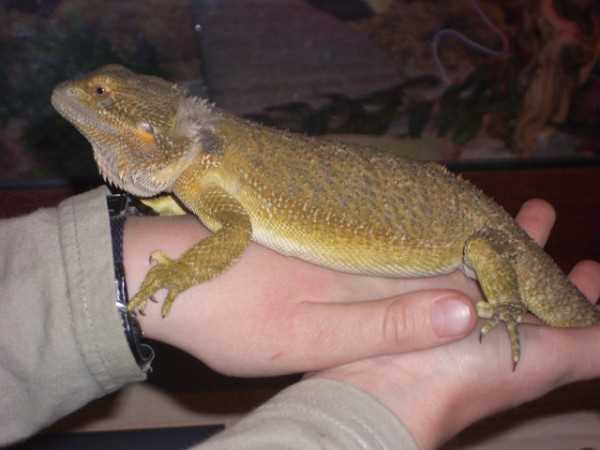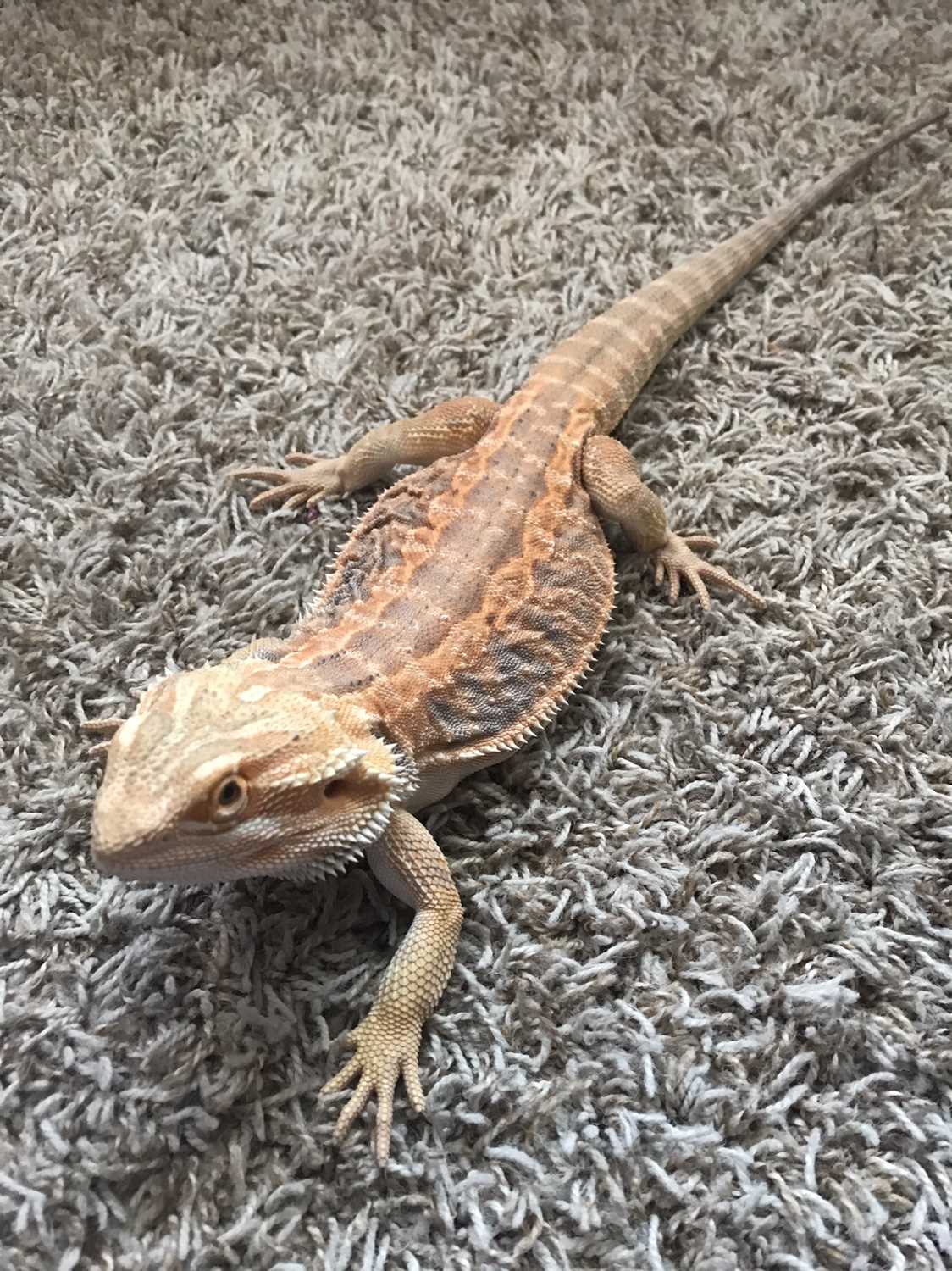Proper Diet for an Aging Bearded Dragon
1. Consider the nutritional requirements:
Older bearded dragons have different nutritional needs compared to younger ones. Their metabolism slows down, which means they require fewer calories. However, their need for certain nutrients, such as calcium and vitamins, increases. To meet their nutritional requirements, it’s essential to offer a varied diet.
2. Provide a balance of proteins, vegetables, and fruits:
3. Avoid foods that are difficult to digest:

4. Offer calcium and vitamin supplements:
Older bearded dragons are more prone to calcium deficiencies and bone-related issues, such as metabolic bone disease. To prevent these problems, provide them with calcium and vitamin supplements. Dust their food with a reptile calcium supplement, or offer them gut-loaded insects that have been fed with high-calcium diets.
5. Pay attention to hydration:
Older bearded dragons may develop dehydration more easily than younger ones. Ensure they have access to clean, fresh water at all times. You can also offer them water-rich fruits, such as cucumbers or melons. However, be mindful that excessive water intake can be detrimental, so balance hydration accordingly.
Maintaining the Correct Temperature and Lighting for Your Aging Bearded Dragon
As your bearded dragon ages, it becomes even more important to provide proper temperature and lighting conditions to ensure its health and well-being. Here are some tips on how to maintain the correct environment for your aging dragon:
1. Temperature
Bearded dragons require a basking spot with a temperature of 95-105°F (35-40°C) during the day. This allows them to regulate their body temperature and aids in digestion. However, older dragons may have a harder time regulating their body temperature, so it’s crucial to provide them with a warm and comfortable basking spot.
At night, the ambient temperature in the tank should drop to around 70-75°F (21-24°C). This temperature drop mimics the natural temperature fluctuations in their native habitats and helps regulate their sleep patterns.
2. Lighting
UVA light, on the other hand, provides them with the full spectrum of light that they would receive in their natural environment. This light is important for their mental well-being and helps stimulate natural behaviors.
Proper placement of the lights is also crucial. Ensure that the UVB light is positioned within 6-12 inches of the basking spot to allow your bearded dragon to receive adequate exposure. The UVA light should be placed in a way that it covers the entire enclosure.
Remember to provide a proper photoperiod to mimic the day and night cycle. A 12-14 hour light cycle during the day followed by 10-12 hours of complete darkness at night is recommended.
Monitoring hydration and providing water sources for an old bearded dragon
As bearded dragons age, it becomes increasingly important to monitor their hydration levels and provide them with adequate water sources. Dehydration can be a serious issue for older bearded dragons and can lead to various health problems.
One way to monitor hydration is by observing the skin elasticity. In a well-hydrated bearded dragon, the skin will be elastic and will quickly return to its original position when gently pulled. If the skin stays tented or takes longer to return to normal, it may indicate dehydration.
In addition to a shallow dish of water, you can also offer your older bearded dragon water through misting. Misting the enclosure with a fine spray bottle can help increase humidity and provide an additional water source for the bearded dragon. This can be especially beneficial if your reptile is showing signs of reluctance to drink from a dish.
| Signs of dehydration in an old bearded dragon: | Preventive Measures: |
|---|---|
| – Sunken eyes | – Ensure fresh water is always available |
| – Loss of appetite | – Monitor daily water intake |
| – Reduced urination | – Mist the enclosure regularly |
| – Dry, wrinkled skin | – Offer water through misting or dropper |
| – Lethargy and weakness | – Provide a balanced diet with hydrating foods |
Monitoring your old bearded dragon’s hydration and providing ample water sources can help prevent dehydration and ensure their overall well-being. It is essential to pay attention to any signs of dehydration and take appropriate measures to keep your reptile friend healthy and hydrated.
Tips for Regular Veterinary Check-ups for Senior Bearded Dragons
1. Find a Reptile-Experienced Veterinarian
When selecting a veterinarian for your senior bearded dragon, it is crucial to find one with experience in reptile medicine. Reptiles have unique anatomy and physiology, and a veterinarian who specializes in reptiles will be better equipped to provide appropriate care and treatment for your dragon.
2. Regular Check-ups
As your bearded dragon ages, regular check-ups should be scheduled at least once a year, if not more frequently. These check-ups allow the veterinarian to assess your dragon’s overall health, weight, and any potential issues that may arise.
3. Diagnostic Tests
During check-ups, the veterinarian may recommend diagnostic tests to monitor your dragon’s health. These tests may include bloodwork, fecal exams, or radiographs to evaluate organ function and detect any underlying problems.
4. Vaccinations
5. Dental Care
Dental health should also be monitored during veterinary check-ups. Bearded dragons can develop dental issues, such as overgrown or infected teeth, which can cause significant discomfort. The veterinarian can assess the condition of your dragon’s mouth and provide appropriate dental care if needed.
6. Parasite Prevention
Parasites, such as mites or intestinal worms, can affect bearded dragons. Regular veterinary check-ups provide an opportunity to screen for and treat any parasite infestations. Your veterinarian can recommend a suitable parasite prevention plan based on your dragon’s age and health status.
7. Follow-up Care and Medications
If your veterinarian prescribes any medications or treatments for your senior bearded dragon, it is essential to follow their instructions carefully. Bearded dragons can be sensitive to certain medications, and it is vital to administer them correctly to avoid any adverse reactions.
By following these tips and regularly visiting a reptile-experienced veterinarian, you can ensure that your senior bearded dragon receives the necessary care and attention to maintain optimal health and well-being.
Adjusting the Enclosure for an Older Bearded Dragon
1. Provide Easy Access to All Areas
Older bearded dragons may experience joint stiffness or mobility issues. Make sure their enclosure allows them easy access to all essential areas such as basking spots, hiding places, food, and water dishes. Consider placing ramps or platforms to help them navigate their enclosure more easily.
2. Create a Soft Substrate
To prevent injuries and maintain comfort, replace hard substrates like gravel or rough rocks with a softer bedding material. You can use reptile carpet, smooth tiles, or paper towels as a substrate. Avoid using loose substrates that can be accidentally ingested and cause impaction.
3. Ensure Proper Temperature Gradients
Older bearded dragons may have difficulties regulating their body temperature, so it’s crucial to provide a well-defined temperature gradient in their enclosure. Use a reliable thermometer to monitor the temperature at different spots and adjust the heat sources accordingly. Ensure that there are cooler areas for them to retreat to if they become too hot.
4. Decrease the Height of Basking Spots
As bearded dragons age, they may have difficulty climbing or jumping onto higher basking spots. Lower the height of their basking platforms or add additional lower ones to accommodate their reduced mobility. This way, they can still bask comfortably and receive enough heat and UVB exposure.
Overall, providing a suitable and adapted enclosure for an older bearded dragon is crucial for their health and happiness. Regularly assess their needs and make adjustments accordingly to ensure they can enjoy their space comfortably throughout their senior years.
Providing mental stimulation and enrichment for your old bearded dragon
- Toys: Introduce a variety of toys into your bearded dragon’s enclosure. Items such as tunnels, balls, and puzzles can help stimulate their mind and encourage exploration.
- Obstacle courses: Create an obstacle course using rocks, branches, and other materials that your bearded dragon can navigate through. This will not only provide mental stimulation but also help them maintain their physical abilities.
- Training: Bearded dragons can be trained to perform simple tricks and tasks. Teaching them to respond to cues or hand signals can challenge their brain and strengthen the bond between you and your pet.
- Food enrichment: Offer food in different ways to make mealtime more interesting. Use puzzle feeders or hide insects around the enclosure to encourage foraging behavior.
- Environmental changes: Regularly rearrange your bearded dragon’s enclosure by adding new decorations or changing the layout. This will provide them with a fresh and stimulating environment.
Recognizing and Managing Common Health Issues in Older Bearded Dragons
1. Metabolic Bone Disease (MBD)
Older bearded dragons are at a higher risk of developing metabolic bone disease, a condition that affects their bone health. This can be caused by a lack of proper calcium and vitamin D3 in their diet. Symptoms of MBD include weakness, swollen limbs, and deformities. To prevent and manage MBD, owners should provide a balanced diet containing calcium-rich foods and ensure their bearded dragons have access to proper UVB lighting.
2. Kidney Disease
As bearded dragons age, their kidneys may become less efficient at filtering waste and toxins from the body. This can lead to kidney disease, which can cause symptoms such as loss of appetite, weight loss, and increased thirst. To manage kidney disease, owners should monitor their bearded dragon’s hydration levels and provide a balanced and easily digestible diet. Regular veterinary check-ups are also crucial for early detection and management of kidney disease.
3. Respiratory Infections

Older bearded dragons may be more prone to respiratory infections due to a weakened immune system. Common symptoms of respiratory infections include wheezing, labored breathing, and mucus discharge from the nose or mouth. To prevent and manage respiratory infections, owners should ensure their bearded dragons’ enclosure is properly heated and free from drafts. Regular cleaning and disinfection of the enclosure can also help reduce the risk of respiratory infections.
4. Impaction
Impaction occurs when a bearded dragon ingests a foreign object or has difficulty passing waste. Older bearded dragons may be at a higher risk of impaction due to decreased mobility and digestion. Symptoms of impaction include bloating, loss of appetite, and straining during defecation. To prevent and manage impaction, owners should provide a proper substrate that is easy to digest, monitor their bearded dragon’s bowel movements, and ensure their pet has access to clean water for hydration.
Conclusion: As bearded dragons age, they require extra care and attention to manage common health issues. By recognizing the symptoms and taking appropriate measures, owners can ensure their older bearded dragons lead happy and healthy lives.

I’m Lena Adams—a product of an unconventional upbringing in the African wilderness. My father, a daring explorer of African wildlife, sparked my fascination with reptiles, a passion that intertwined with the tragic loss of my mother during an expedition, leaving an indelible mark on my life. Driven to understand the creatures that captivated my parents, I embarked on my journey, sharing insights about reptiles, frogs, and lizards on my website. Through my explorations and conservation efforts, I honour my family’s legacy while seeking connections—to the creatures, nature, and the mother whose presence I yearn to understand.
